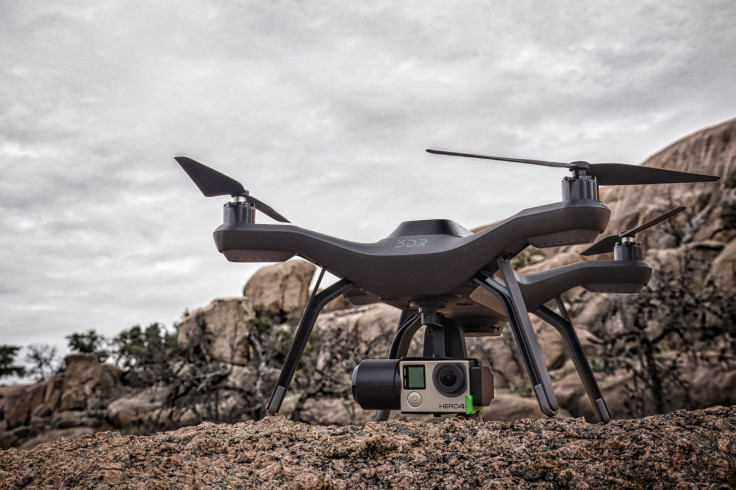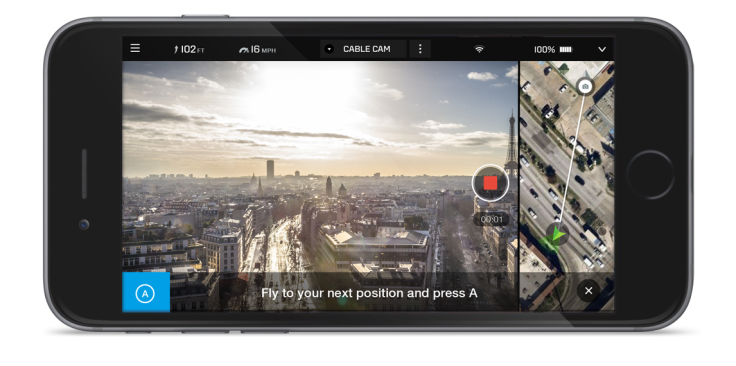3D Robotics debuts Solo smart drone that can fly by itself while you focus on the camera

US consumer drones manufacturer 3D Robotics is taking China's DJI on with a new "smart drone" that has enough computing power to fly autonomously by itself while you just focus on controlling the photography and video you want to capture.
The new unmanned aerial vehicle (UAV), dubbed Solo, features several industry firsts. It comes with not one, but two integrated Linux computers (one on the craft and one in the controller), a smart battery that sends data back wirelessly to the accompanying mobile app, direct access to the GoPro camera controls during the flight and live wireless HD video streaming straight to the iOS or Android mobile app.
As for the exact specs, the controller's battery life is up to four hours with the option to extend it up to eight hours. Flight time lasts up to 25 minutes without a payload, or up to 20 minutes with the GoPro and gimbal attached.
In order to make it possible for the operator to control the camera on the UAV remotely, Wi-Fi lasts up to 800m away, and video latency is 180 milliseconds.
No longer a toy to be thrown away one day

3D Robotics is keen to take away the hassle of requiring two drone operators to control a drone for film work, instead making it possible for the pilot to both fly and achieve the perfect shot at the same time.
The combined processing power together with the patent-pending Smart Shots software makes it possible for the drone to carry out pre-planned flight paths to capture specific shots, just like the UAVs used in Hollywood do.
"Solo will expand our concept of what a drone can be and do," said Chris Anderson, CEO of 3DR. "Solo uses advanced autonomy to make creativity easier. Rather than needing skill to capture a great shot, you can let the software do the work. Even better, you can be in the shot—you can be the subject of your life's story, not just the director."

Also, the firm wants owners to be able to upgrade their drone rather than just buying a new one, and to that end, it is possible to swap out several parts of the device, like gimbals and motors, and there is an accessory bay where different imaging devices and features like an LED lighting system, indoor flight stabiliser or ballistic parachute system can be plugged in.
Apart from autopilot, the Solo app logs all flights you make, and if anything goes wrong with your drone during flights, the app asks you if you would like to submit a service request with 3D Robotics' support team. The firm also promises to replace any part of the drone that is lost or damaged during flights if the app logs show that it was due to a server error.
Could Solo become the iPhone of drones?
Many of the features on the Solo already sound pretty impressive, but there's also DroneKit, the open platform 3D Robotics launched in March that enables the firm to share its flight control technology with developers that want to design apps for flying and controlling the apps better.
The platform already has partnerships with Qualcomm, Intel and the Linux Foundation, and by focusing on building an app ecosystem for Solo like the one Steve Jobs successfully created for the iPhone, it looks like 3D Robotics is pushing to make drones more relevant that being simply a cool toy that you throw away when it becomes obsolete.
"We're the only open platform out there. Our competitors have fantastic products, but they're not platforms," Anderson told CNET.
"This is like the PC or the early days of the App Store. Who knows what these things will some day become. What we want to do is create a system by which other people can re-imagine the future of the drone and then act on them simply."
The 3D Robotics Solo will be available to buy in the US from May, and launched in the rest of the world in June and July. Prices will start from $999 (£685), which comes in cheaper than both the new Phantom 3 line of drones launched by DJI on 8 April.
© Copyright IBTimes 2025. All rights reserved.






















